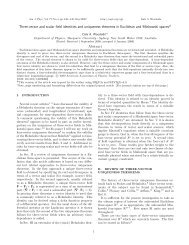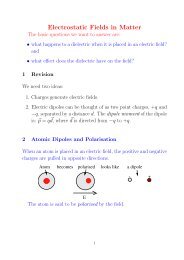Chapter 8 Vector Spaces in Quantum Mechanics
Chapter 8 Vector Spaces in Quantum Mechanics
Chapter 8 Vector Spaces in Quantum Mechanics
You also want an ePaper? Increase the reach of your titles
YUMPU automatically turns print PDFs into web optimized ePapers that Google loves.
<strong>Chapter</strong> 8 <strong>Vector</strong> <strong>Spaces</strong> <strong>in</strong> <strong>Quantum</strong> <strong>Mechanics</strong> 99Normalized states are states for which probability is properly taken <strong>in</strong>to account. It ismathematically convenient to permit the use of states whose norms are not equal to unity,but it is necessary <strong>in</strong> order to make use of the probability <strong>in</strong>terpretation to deal only withthat state which has norm of unity. Any state that cannot be normalized to unity (i.e. it isof <strong>in</strong>f<strong>in</strong>ite length) cannot represent a physically acceptable state.8. Two states |φ〉 and |ψ〉 are orthogonal if 〈φ|ψ〉 = 0.The physical significance of two states be<strong>in</strong>g orthogonal should be understood: for asystem <strong>in</strong> a certa<strong>in</strong> state, there is zero probability of it be<strong>in</strong>g observed <strong>in</strong> a state withwhich it is orthogonal. In this sense, two orthogonal states are as dist<strong>in</strong>ct as it is possiblefor two states to be.F<strong>in</strong>ally, a set of orthonormal basis vectors {|ϕ n 〉; n = 1, 2, . . . } will have the property9. 〈ϕ m |ϕ n 〉 = δ mn where δ mn is known as the Kronecker delta, and equals unity if m = nand zero if m n.All the above conditions satisfied by probability amplitudes were to a greater or lesserextent physically motivated, but it nevertheless turns out that these conditions are identicalto the conditions that are used to def<strong>in</strong>e the <strong>in</strong>ner product of two vectors <strong>in</strong> a complexvector space, <strong>in</strong> this case, the state space of the system, i.e. we could write, us<strong>in</strong>g theusual mathematical notation for an <strong>in</strong>ner product, 〈φ|ψ〉 = (|φ〉, |ψ〉). The state space ofa physical system is thus more than just a complex vector space, it is a vector spaceon which there is def<strong>in</strong>ed an <strong>in</strong>ner product, and so is more correctly termed a complex‘<strong>in</strong>ner product’ space. However, it is usually required <strong>in</strong> quantum mechanics that certa<strong>in</strong>convergency criteria, def<strong>in</strong>ed <strong>in</strong> terms of the norms of sequences of vectors belong<strong>in</strong>g tothe state space, must be satisfied. This is not of any concern for spaces of f<strong>in</strong>ite dimension,but are important for spaces of <strong>in</strong>f<strong>in</strong>ite dimension. If these criteria are satisfied then thestate space is said to be a Hilbert space. Thus rather than referr<strong>in</strong>g to the state space of asystem, reference is made to the Hilbert space of the system.It is important to recognize that all the vectors belong<strong>in</strong>g to a Hilbert space have f<strong>in</strong>itenorm, or, putt<strong>in</strong>g it another way, all the state vectors can be normalized to unity – thisstate of affairs is physically necessary if we want to be able to apply the probability <strong>in</strong>terpretation<strong>in</strong> a consistent way. However, as we shall see, we will encounter states whichdo not have a f<strong>in</strong>ite norm and hence neither represent physically realizable states, nor dothey belong to the state or Hilbert space of the system. Nevertheless, with proper care regard<strong>in</strong>gtheir use and <strong>in</strong>terpretation, such states turn out to be essential, and play a crucialrole throughout quantum mechanics. Recogniz<strong>in</strong>g that a probability amplitude is noth<strong>in</strong>gbut an <strong>in</strong>ner product on the state space of the system, leads to a more general way ofdef<strong>in</strong><strong>in</strong>g what is meant by a bra vector. The follow<strong>in</strong>g discussion emphasizes the fact thata bra vector, while it shares many characteristices of a ket vector, is actually a differentmathematical entity.Bra <strong>Vector</strong>sWe have consistently used the notation 〈φ|ψ〉 to represent a probability amplitude, but wehave just seen that this quantity is <strong>in</strong> fact noth<strong>in</strong>g more than the <strong>in</strong>ner product of two state
















